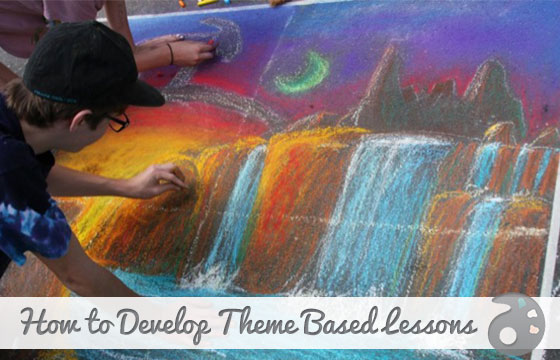When writing lesson plans, most teachers start with the objective: What will the student be able to do? The objective might include concepts ranging from the elements and principles of design to art techniques or even art materials. Usually, it is only after the objective is in place that a theme is presented. For example, a common objective at the high school level is gaining an understanding of perspective. In order to demonstrate that the objective was learned, the students might be asked to draw within the theme of a cityscape.
Theme teaching, on the other hand, presents the same information but reverses the order, simulating the way many artists work.
Artists rarely begin by asking themselves, “I’ll work in 1 point perspective today. What should I create?” Instead, they may be inspired to create a cityscape after a trip to New York City. Then, they may select 1 point perspective as a means of accomplishing that goal.
Theme teaching begins by presenting the student with a question or topic to inspire thought. The student considers the theme and then generates a series of possible solutions. From these possibilities, the student selects a final idea for his or her project.
It is only after the final idea has been determined that the student considers what materials to use and the techniques he or she may need to learn.
Theme teaching puts a student in charge of his or her own learning.
It transforms his or her thinking from that of a student to that of an artist. Below are three different ways you could present themes in your art room, from simple to more complicated.

Descriptive Themes
Descriptive Themes are basic, making them a nice starting point. Descriptive themes pose more concrete questions to students.
Examples include:
1. What’s behind the door?
2. It happened one night…
3. The bus ride home…
Abstract Themes
Abstract themes are less concrete and even more open-ended.
Examples include:
1. Play
2. Systems
3. Autobiographical
Postmodern Principles
Postmodern Principals are themes that require higher level thinking, making them a good choice to try once you’re feeling more comfortable with presenting projects this way.
Examples include:
1. Juxtaposition
2. Layering
3. Interactivity
So tell us, have you tried theme teaching before?
Can you see theme teaching working at younger grade levels?
What themes do you think would be most inspiring for students?
Magazine articles and podcasts are opinions of professional education contributors and do not necessarily represent the position of the Art of Education University (AOEU) or its academic offerings. Contributors use terms in the way they are most often talked about in the scope of their educational experiences.




